|
NATIONAL PARK SERVICE
Park Structures and Facilities |

|
SERVICE BUILDINGS and UTILITIES
THAT FACILITY least contacted by the using public, the maintenance building in parks, needs to make least effort in gesture to its environment, if it is properly located. Generally speaking, its location is off the track beaten by park patrons, and is an isolated and well-obscured one, where this stepchild among park structures need not suffer unfavorable comparison with necessarily more self-conscious and better groomed neighbors. This is not to say that it need not be conveniently located. Inconspicuous convenience is the qualification. If such a site is not available, then the service building must go in for protective coloration, and perhaps to a greater degree than other buildings because it is so completely nonrecreational and without the saving grace of very apparent direct benefit to the public itself. Its reason for being is so little sensed by the unanalytical public mind that its presence is more than likely to be subconsciously resented.
The typical service or facilitating buildings within parks provide for the housing of trucks, equipment, implements and supplies necessary to park maintenance. They are sometimes referred to as maintenance, utility or equipment buildings. Often provision must be made for the stabling of work horses, or of one or more saddle horses used by caretaker, ranger or others of the park personnel in their duties. This leads to need for space in which to store wagons and feed. Repair shop, carpenter and paint shop, and winter storage space for park furniture are among space requirements not unusual to parks of any considerable size. These and countless other service space needs crop up so progressively during park development that the service building seems always to be in process of change, or in crying need of it. Indeed it is foolhardy to look upon the most carefully considered and planned initial structure as the fixed ultimate for a service building or group. It may serve perfectly the need of the moment. But there is nothing within parks more legitimately subject to change than service and facilitating needs during development, and few parks are recorded as having finally passed that stage. The very choice of site for the service center should be predicated upon expansion, possibilities beyond all reasonable limits foreseen at the start, and the wise technician will clearly see and cannily plan the initial structure as an extensible building, or as one unit with which others can be joined or grouped.
Probably the happiest and most forehanded visualization of the ultimate service group is a square service courtyard surrounded by all the facilitating structures. If, at the starting gong, the required buildings utilize but one, or at most two, sides of the eventual courtyard, the planner need not feel regretful concern for its incompleteness. Time will correct that, and speedily. His concern might more profitably be for how the threat of future additions will be met after structures have raced their way to enclose all sides of the courtyard. He may almost find that to maintain any opening for access to the service court is his real problem.
The chief advantage of the "hollow square" plan for a service group is the confinement of maintenance activities and paraphernalia to an area that becomes ultimately screened from public view as the expanding structures proceed to enclose it. Cavernous openings for entrance of trucks and equipment, factory-like windows so necessary for ample lighting of work spaces, all the inharmonious and unparklike can be made to open on the court, while the walls exposed to public view need not shout stridently the maintenance activities within. This results in an opportunity to limit "eye appeal" construction to the exposed outer walls, and to resort to strictly practicable and serviceable construction within the court. The enclosure serves also to accommodate and screen from view any equipment which need not be kept under roof. It masks the loading and unloading of supplies, the arrival and departure of work crews.
The park patron is fended off from wandering into the activities of the maintenance base with which his recreational use is not properly involved, and limits are created to prevent a loose overflow of maintenance facilities into areas that the public should be privileged to claim for its own. Confined to their own fixed precinct, hemmed in and obscured by their own requirements of structure, the activities and facilities which have to do with the mechanics of development and maintenance need not constitute a disfigurement of a preserve of Nature.
Certain facilities in parks can almost be termed utilities. The supply of safe drinking water and sanitary toilets, already cited as "first things" in the development of a natural area, are of this nature. Also in this category and hardly second in importance is the need for the disposal of garbage and rubbish for the maintenance of healthful and sightly conditions. As surely as drinking water must be provided and kept uncontaminated and sewage disposal provided and kept uncontaminating, so must garbage and rubbish disposal be positive and complete. The undertaking may not be haphazard. The incinerator is the structural medium, but it is not automatic and depends entirely on the human equation for its effectiveness. Tending of the incinerator, and all the preliminary routine of garbage and rubbish collection, must be regular and diligent.
The incinerator can be one of innumerable forms. Important are the considerations of ample capacity, the employment of heat resisting materials, and both the draining of accumulated waste prior to burning and provision of abundant draft to insure maximum combustion. Desirable are overhead shelter for the attendant operating the incinerator and convenient method of charging.
It is regrettable if the flue must be tall and unsightly, but it is more regrettable if, in attempting to overcome this, the draft is reduced beyond the desirable maximum and unnecessary smoke and stench are the result.
Incinerators should be located conveniently near to the intensively used areas, yet must be decently retired so that their nuisance quality is minimized. Prevailing air currents should be studied before the site is determined. Tree growth and other natural screening from view are only advantageous if they do not also become obstructions to draft.
It might be said in short that incinerators, service structures, and all such other phases of park operation which by their nature are capable of functioning without direct contact with the public, function best if kept out of its sight and out of its path.
Maintenance and Equipment Building, Levi Jackson-Wilderness Road State Park, Kentucky
Decorously unpretentious, this substantial and well-arranged building supplies housing and repair shop for park automotive equipment. Location in a wooded tract has shielded it from any temptation to glorify with sports clothing a building that looks so well in clean overalls. The masonry of the chimney is well done, the roof texture adequate.
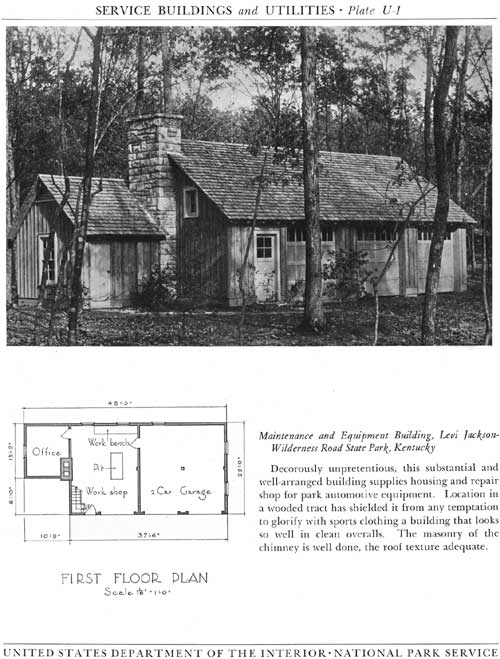
|
| Plate U-1 (click on image for a PDF version) |
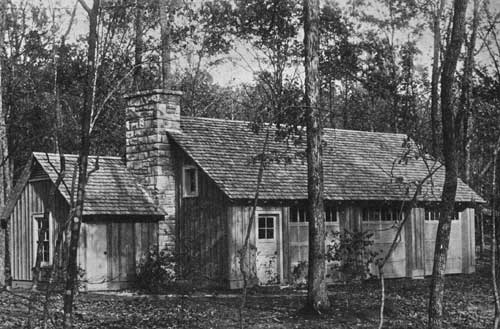
|
| Levi Jackson-Wilderness Road State Park, Kentucky |
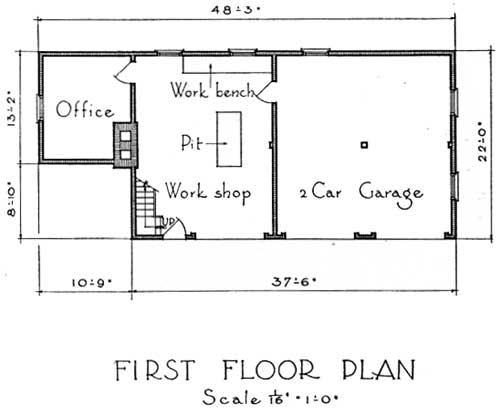
|
| Levi Jackson-Wilderness Road State Park, Kentucky |
Equipment and Maintenance Building, Scenic State Park, Minnesota
A mere facilitating building glorified by the excellent log work almost invariably found in Minnesota. When all structures in parks exemplify the sturdy forthrightness of this example, many existing buildings will have been replaced.
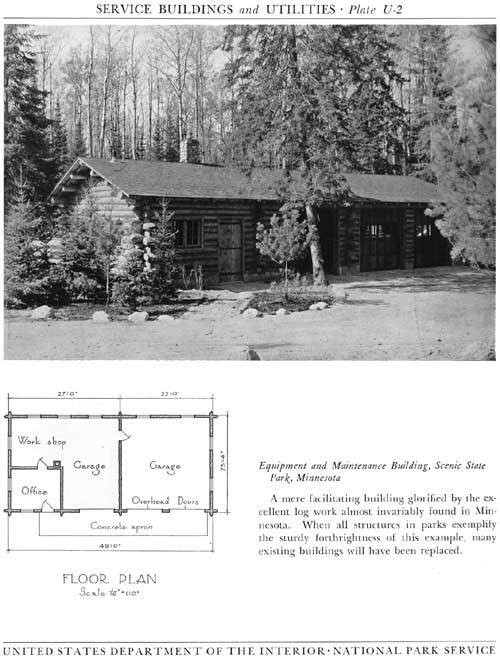
|
| Plate U-2 (click on image for a PDF version) |

|
| Scenic State Park, Minnesota |
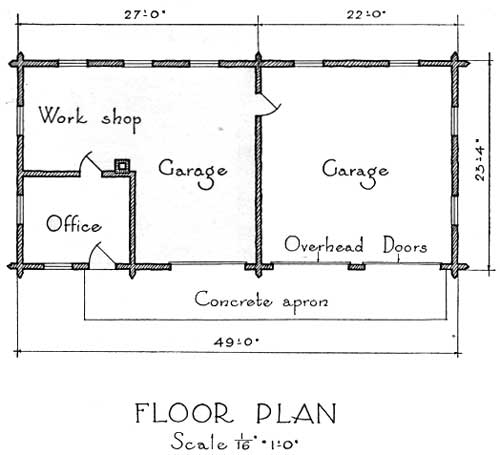
|
| Scenic State Park, Minnesota |
Storage Building, Scenic State Park, Minnesota
Obviously close kin to the equipment and maintenance building of this same park through the family trait of excellent log construction. The projecting logs at the corners keep within allowable limits of rakishness and enliven the general effect. The ridge capped with a pole should be noted. Ice, wood and tools are stored in the building. The ice storage room is lined with insulating material.
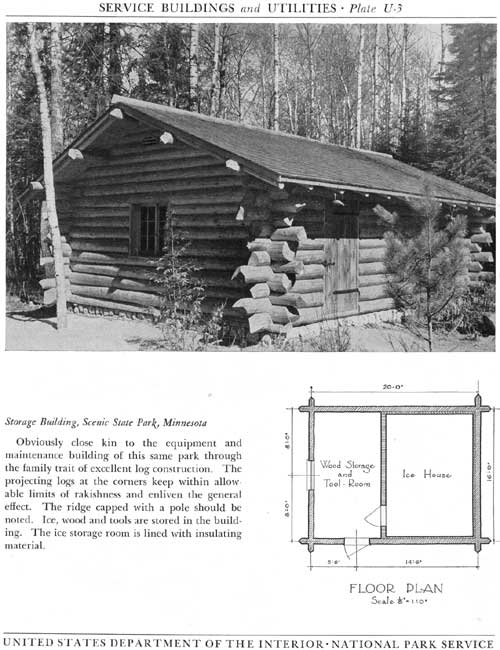
|
| Plate U-3 (click on image for a PDF version) |
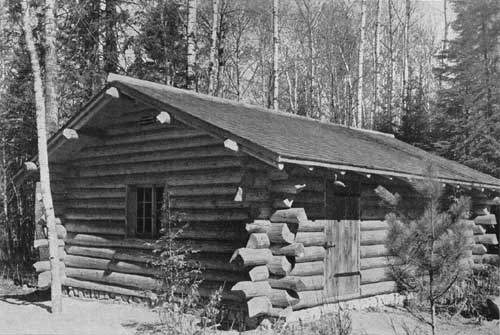
|
| Scenic State Park, Minnesota |
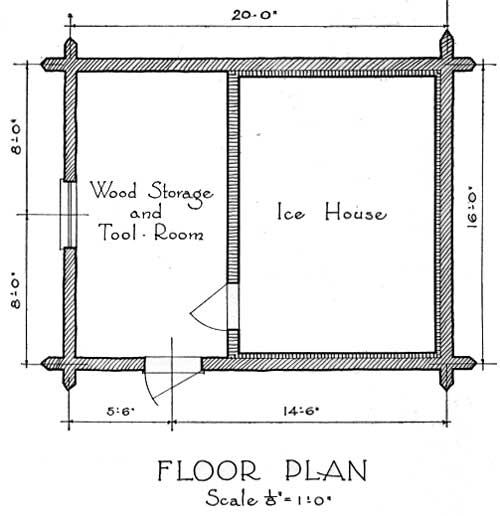
|
| Scenic State Park, Minnesota |
Service Building, Pilot Knob State Park, Iowa
Exhibiting a degree of structural permanence seldom found in maintenance and equipment buildings in parks. By no means a fault—unless its site is injudiciously selected. Second thoughts on suitable locations for buildings facilitating maintenance are not unheard of. The end garage stall has the appearance of being a later addition. If the pattern of the past forecasts the future, this is the first of a probable succession of extensions in provision of necessary service space.
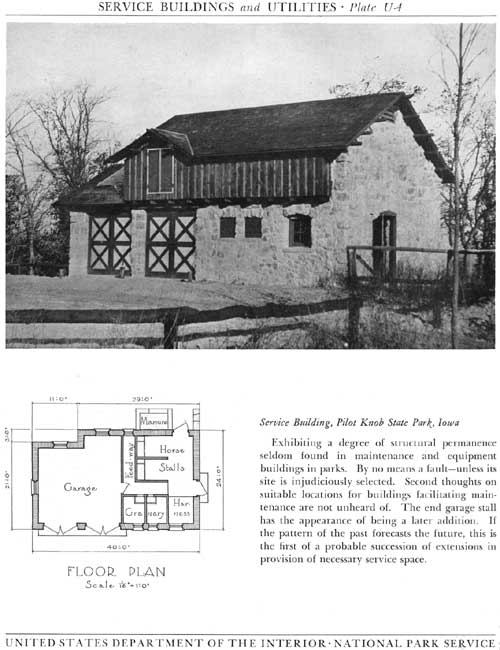
|
| Plate U-4 (click on image for a PDF version) |

|
| Pilot Knob State Park, Iowa |
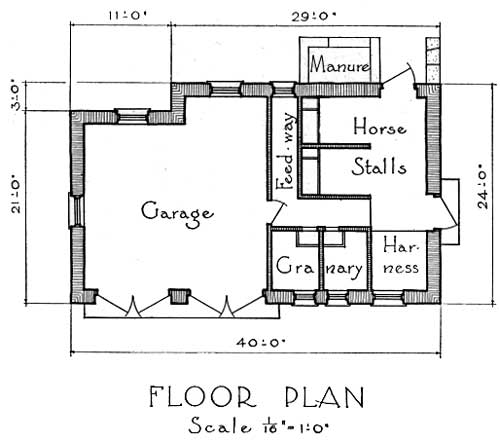
|
| Pilot Knob State Park, Iowa |
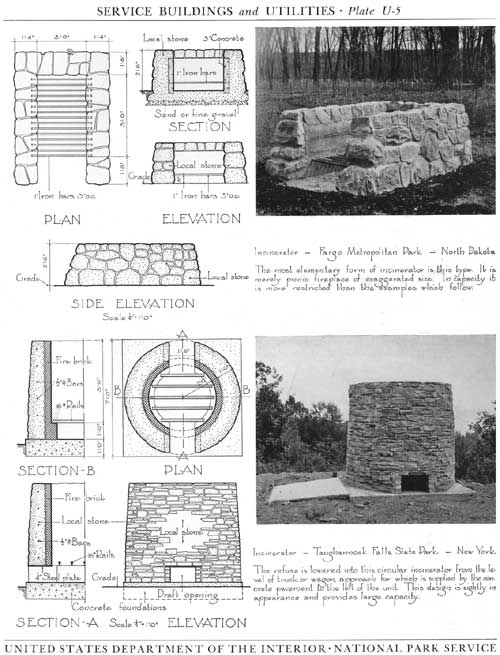
|
| Plate U-5 (click on image for a PDF version) |
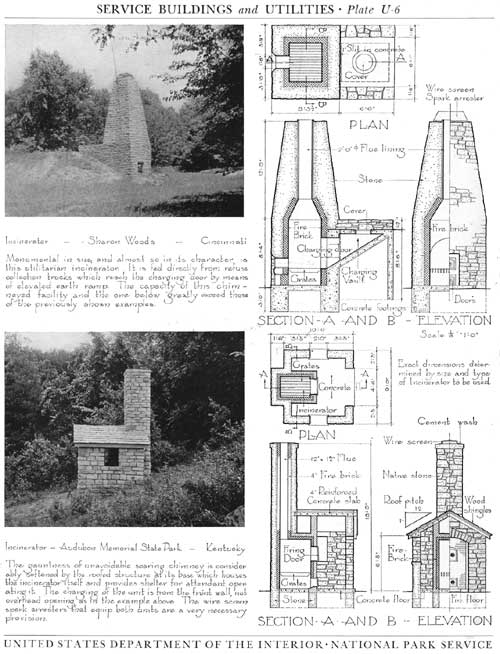
|
| Plate U-6 (click on image for a PDF version) |
| <<< Previous | <<< Contents>>> |
park_structures_facilities/secu.htm
Last Updated: 5-Dec-2011